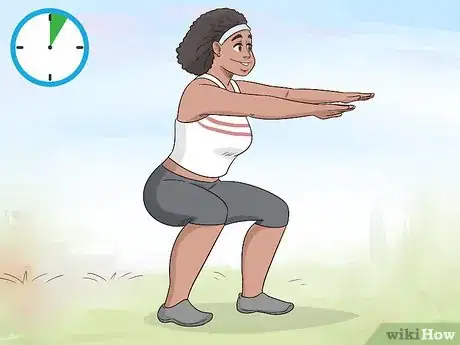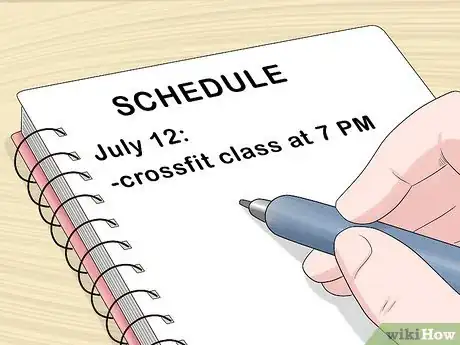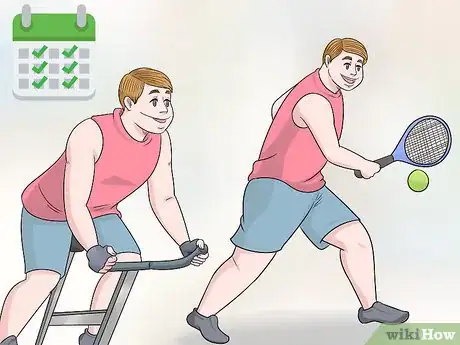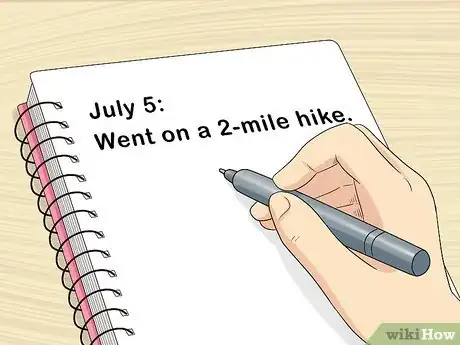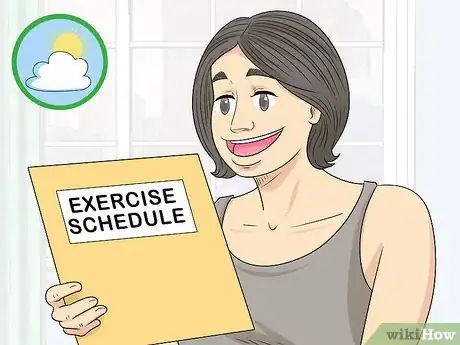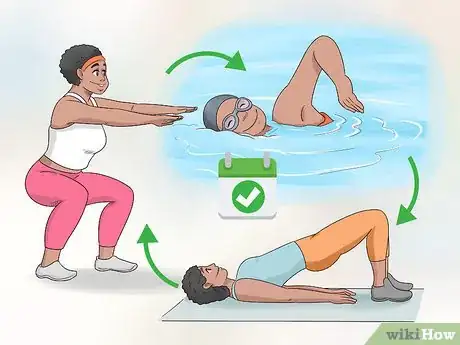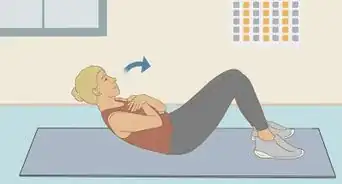This article was co-authored by Isaac Hess. Isaac Hess is a Baseball Coach, Instructor, and the Founder of MADE Baseball Development and Champion Mindset Training Program, a baseball training program based in Los Angeles, California. Isaac has over 14 years of experience coaching baseball and specializes in private lessons and tournaments. He has played baseball for both professional and collegiate leagues including Washington State University and the University of Arizona. Isaac was ranked as one of Baseball America's top 10 prospects for 2007 and 2008. He earned a BS in Regional Development from the University of Arizona in 2007.
There are 13 references cited in this article, which can be found at the bottom of the page.
This article has been viewed 265,007 times.
Establishing an exercise schedule can help organize your routine and hold you accountable to your workouts. If you can plan at least 1 cardiovascular exercise, strength training exercise, and rest day into your weekly schedule, you can make a balanced workout routine. Follow your schedule for at least 6 weeks, on good days and bad days, to make it a habit. Before you know it, you'll have established an organized and effective exercise schedule!
Steps
Finding Time for Workouts
-
1Start by planning smaller workout sessions. If you're new to making an exercise routine, begin by scheduling short, but frequent sessions. Begin with 5-10 minute sessions a day and gradually work your way up to 30-minute or even hour-long sessions.[1]
- With exercise, every session counts. It's better to have 3-4 20-minute workouts a week than a single 2-hour session.[2]
- If you can't find time for a full 30-minute session, try breaking your workout into several smaller sessions. You might, for example, fit in 2 15-minute workouts instead.
- You'll form a habit more easily if you exercise every day, even if it is only for 10-15 minutes. If you have a busy day, try to squeeze in at least a brisk walk, a few running laps around the block, or a 15-minute Pilates session.
-
2Repurpose your free time for exercising if you have a busy schedule. Sometimes if you have a hectic schedule, you have to make time for exercise. Evaluate how you spend your average day and, wherever you can, delegate extra time to working out.[3]
- If you spend lots of time on social media, for example, exercise with that free time instead.
Advertisement -
3Schedule gym time around your favorite TV series if this motivates you. Watching a TV show you love can be good motivation to exercise at a specific time. Look up when the next episode of your favorite TV show is and plan your workout at that time or watch episodes using a video streaming website as you work out.[4]
- If you're currently watching Parks and Recreation, for example, you could take your phone with you to the gym and watch it as you run on the treadmill.
- You can also work out from home while watching your favorite show on TV.
-
4Set your alarm an hour or half-hour earlier if you don't have time during the day. If your day schedule is a little hectic, try waking up 30-60 minutes earlier than you usually do. That could give you enough time to fit in a morning run or exercise session before your day begins.[5]
- If you work out in the morning, go to sleep wearing your exercise clothes so you don't waste time getting ready.
-
5Choose to workout at a specific time, if that motivates you. Holding yourself responsible for your workouts can help you make exercise a priority. You could purchase a gym membership, join a sports team, or find a workout partner so you have a specific time and place to workout.[6]
- You can also take exercise classes at your local gym or recreation center. Depending on your preference, you could take yoga, Zumba, aerobics, cycling, strength training, or other popular fitness classes.
- If you'd prefer to work one-on-one with someone, hire a personal trainer. They can help you improve your overall fitness and hold you responsible for a specific appointment.
-
6Plan an at-home exercise routine as an alternative to gym workouts. You don't need to go to the gym to get a good workout. If you don't have time for traveling, you can always exercise by doing chores, jogging around your neighborhood, or working out at home.[7]
- If you have a dog, for example, you could count walking it as exercise.
- You don't need special equipment to work out at home. Following exercise videos on YouTube is a great way to get a quality workout without leaving your home.
Organizing Your Exercise Schedule
-
1Write your exercise schedule online or on paper. Physically writing your schedule will help you feel more accountable than keeping it in your mind. Depending on what's most convenient for you, you could write it in a paper, online, or app planner.[8]
- You can, for example, write in your schedule, "March 10th: Go to the gym's crossfit class at 7 PM."
-
2Start slowly when you begin. If you did not regularly exercise before, don't start off with high intensity or long workouts. You may accidentally injure yourself or you might find that your exercise schedule is too difficult to keep up with. Instead, start slowly. Increase the intensity of your workouts over time.[9]
- If you need to, just start out with 10, 15, or 20 minute sessions. As you get stronger and fitter, you can extend the length of your workout.
- If you can't run a mile, break it up into intervals. Run for 5 minutes and then walk for 5 minutes. Over time, run for longer and walk for shorter periods until you can run the whole mile.
-
3Plan 2-3 cardiovascular workouts into your weekly schedule. Cardiovascular workouts raise your heart rate. They may include walking, running, playing sports, cycling, or doing aerobics. Try to include around 2-3 cardiovascular sessions a week.[10]
- You could, for example, go on a run on Monday, attend a cycling class on Wednesday, and play tennis on Sunday for 3 of your weekly workout sessions.
-
4Add 2-3 strength training exercises to your weekly schedule. Strength training workouts build muscle mass. They may include weight lifting, crossfit training, or using weight machines. To keep your schedule balanced, alternate between cardiovascular and strength training exercises every day.[11]
- You could, for example, use weight machines on Tuesday and attend a crossfit class on Saturday for 2 of your weekly workout sessions.
-
5Plan 1-2 rest days into your week. Giving your body a day to recover can prevent injuries and exercise burnout. Take it easy on at least 1 day a week and plan a light, relaxing activity instead of your workout routine.[12]
-
6Alternate between cardio exercise and strength training. To get the most out of your workouts, do cardio 1 day and strength training the next. Incorporate rest days into your schedule as well so you don't overdo it.
- For instance, do cardio on Monday, strength training on Tuesday, rest on Wednesday, cardio on Thursday, strength training on Friday, rest on Saturday, and cardio on Sunday.
-
7Log your workouts. After you've finished an exercise session, write it down in your schedule. Include information like how long your session was, how many steps you took, what you weighed, and any other important details.
- After working out, for example, you could write in your schedule, "November 23rd: Went on a 2-mile hike."
-
8Plan at least one cardio and strength training workout, if you have a busy schedule. If you don't have time to exercise every day, working out 2-3 days a day is a good start for your exercise schedule. Plan a cardio workout and a strength training workout, at minimum, every week to keep your heart healthy while building your muscles.
- If you only have time for 3 workouts, for example, you could plan 2 morning runs and 1 crossfit session.
Making Your Schedule a Habit
-
1Check your exercise schedule every morning. When you wake up, look at your exercise schedule before you do anything else. That way, you can form a mental picture in your head of your daily routine.[14]
- If you write your schedule down, pin it up somewhere near your bed so you can see it right when you wake up.
-
2Do workouts that you enjoy. If you hate weightlifting and are constantly lifting dumbbells in the gym, exercise can seem like a chore. Instead, fill your schedule with exercises that you love so you look forward to following your schedule.[15]
- If you love being in the water, for example, you might swim laps for a cardio workout or attend a water aerobics class.
-
3Follow your schedule when you don't feel like exercising. Establishing your new routine is even more important on days where working out is a struggle. If you're not in the mood for working out, think about the long-term benefits of exercising and how important following your exercise routine is to you.[16]
- Since exercise boosts your endorphins, you may even feel better after working out.
-
4Give your exercise schedule 6 weeks to become a routine. Although the saying traditionally goes that it takes 21 days to establish a habit, it usually takes more like 6 weeks. Push through your schedule for at least 6 weeks and, by the time you make it that long, it should be much easier to follow.[17]
- If your exercise schedule is still hard to follow, you may want to vary the types of exercises you're doing or how long your workout sessions are.
Sample Schedule and Workout Plan Strategies
Expert Q&A
-
QuestionHow do you start working out if you are out of shape?
 Isaac HessIsaac Hess is a Baseball Coach, Instructor, and the Founder of MADE Baseball Development and Champion Mindset Training Program, a baseball training program based in Los Angeles, California. Isaac has over 14 years of experience coaching baseball and specializes in private lessons and tournaments. He has played baseball for both professional and collegiate leagues including Washington State University and the University of Arizona. Isaac was ranked as one of Baseball America's top 10 prospects for 2007 and 2008. He earned a BS in Regional Development from the University of Arizona in 2007.
Isaac HessIsaac Hess is a Baseball Coach, Instructor, and the Founder of MADE Baseball Development and Champion Mindset Training Program, a baseball training program based in Los Angeles, California. Isaac has over 14 years of experience coaching baseball and specializes in private lessons and tournaments. He has played baseball for both professional and collegiate leagues including Washington State University and the University of Arizona. Isaac was ranked as one of Baseball America's top 10 prospects for 2007 and 2008. He earned a BS in Regional Development from the University of Arizona in 2007.
Baseball Coach & Instructor Keep an exercise log every time you work out! This is a great way to hold yourself accountable.
Keep an exercise log every time you work out! This is a great way to hold yourself accountable. -
QuestionHow much should I exercise if I want to maintain my progress?
 Pouya Shafipour, MD, MSDr. Pouya Shafipour is a Family Medicine Specialist, Primary Care Physician, and a Weight Loss Specialist based in Santa Monica, California. Dr. Shafipour specializes in dietary, nutritional, behavioral, and exercise counseling to manage obesity and medical conditions related to excessive weight gain or loss. Dr. Shafipour received a BS in Molecular and Cell Biology from the University of California, Berkeley, an MS in Physiology and Biophysics from Georgetown University, and an MD from the Loma Linda University School of Medicine. He completed his internship in general surgery at UC Irvine and a residency in family medicine at the University of California, Los Angeles, and became board certified in family medicine in 2008.
Pouya Shafipour, MD, MSDr. Pouya Shafipour is a Family Medicine Specialist, Primary Care Physician, and a Weight Loss Specialist based in Santa Monica, California. Dr. Shafipour specializes in dietary, nutritional, behavioral, and exercise counseling to manage obesity and medical conditions related to excessive weight gain or loss. Dr. Shafipour received a BS in Molecular and Cell Biology from the University of California, Berkeley, an MS in Physiology and Biophysics from Georgetown University, and an MD from the Loma Linda University School of Medicine. He completed his internship in general surgery at UC Irvine and a residency in family medicine at the University of California, Los Angeles, and became board certified in family medicine in 2008.
Board Certified Family Medicine Specialist Part of the answer depends on your underlying medical conditions, but 30-60 minutes of exercise daily at least 5 days a week significantly helps with weight maintenance and cardiac health.
Part of the answer depends on your underlying medical conditions, but 30-60 minutes of exercise daily at least 5 days a week significantly helps with weight maintenance and cardiac health. -
QuestionHow can an eight-year-old exercise safely?
 Community AnswerFor children, it's often best that they do sports or get exercise by "play" - playing tag with friends, swimming, riding bikes, etc. If they want to do more traditional forms of exercise, an adult/guardian should be present to guide and supervise.
Community AnswerFor children, it's often best that they do sports or get exercise by "play" - playing tag with friends, swimming, riding bikes, etc. If they want to do more traditional forms of exercise, an adult/guardian should be present to guide and supervise.
Warnings
- Always check with your physician before starting an exercise schedule. This is especially important if you are pregnant, ill, or have a chronic medical condition.⧼thumbs_response⧽
References
- ↑ https://experiencelife.com/article/25-ways-to-make-time-for-fitness/
- ↑ https://www.active.com/fitness/articles/5-ways-to-make-time-for-your-workout-874260
- ↑ https://www.mayoclinic.org/healthy-lifestyle/fitness/in-depth/fitness/art-20044531
- ↑ https://www.realsimple.com/health/fitness-exercise/workouts/15-ways-get-more-fit
- ↑ https://www.fitnessmagazine.com/workout/tips/workout-tips-for-busy-schedules/?page=2
- ↑ https://www.mayoclinic.org/healthy-lifestyle/fitness/in-depth/fitness/art-20044531
- ↑ https://www.active.com/fitness/articles/5-ways-to-make-time-for-your-workout-874260
- ↑ https://experiencelife.com/article/25-ways-to-make-time-for-fitness/
- ↑ https://www.webmd.com/fitness-exercise/features/fitness-beginners-guide
- ↑ https://www.moneycrashers.com/create-free-workout-plan-routines/
- ↑ https://www.mayoclinic.org/healthy-lifestyle/fitness/in-depth/strength-training/art-20046670
- ↑ https://www.helpguide.org/articles/healthy-living/how-to-start-exercising-and-stick-to-it.htm
- ↑ https://www.active.com/running/articles/what-to-do-on-rest-and-recovery-days
- ↑ https://experiencelife.com/article/25-ways-to-make-time-for-fitness/
- ↑ https://www.helpguide.org/articles/healthy-living/how-to-start-exercising-and-stick-to-it.htm
- ↑ https://www.webmd.com/women/features/exercise-habits#1
- ↑ http://www.health.com/health/gallery/0,,20735338,00.html#give-it-six-weeks-0
- ↑ https://www.active.com/fitness/articles/5-ways-to-make-time-for-your-workout-874260
- ↑ https://www.webmd.com/women/features/exercise-habits#1
- ↑ https://www.fitnessmagazine.com/workout/tips/workout-tips-for-busy-schedules/?page=5
